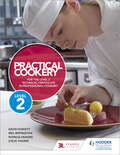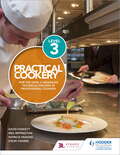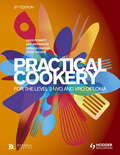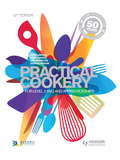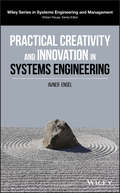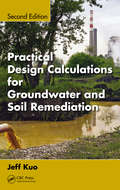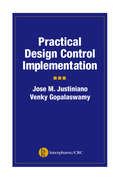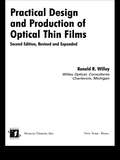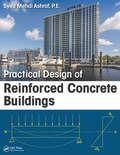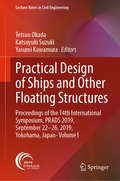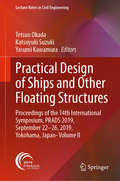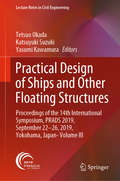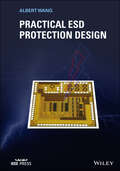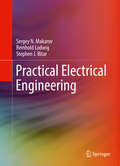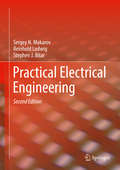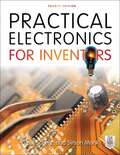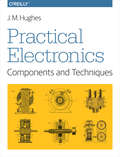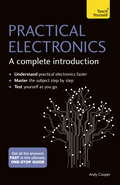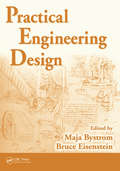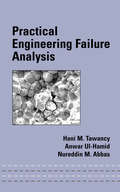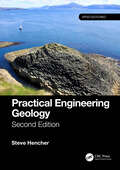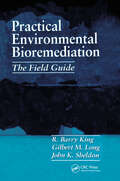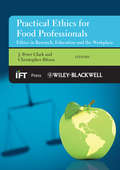- Table View
- List View
Practical Cookery for the Level 2 Technical Certificate in Professional Cookery
by Patricia Paskins Neil Rippington Steve Thorpe Professor David FoskettTailored to the new Level 2 Technical Certificate in Professional Cookery qualification, and covering every aspect of study and assessment, this textbook will ensure your students develop a sound understanding of the core knowledge and skills demanded by the new specification.- Prepares students for both the practical synoptic assignment and the external written exam with practice questions and highly illustrated step-by-step breakdowns of key techniques- Includes classic dishes as well as the latest methods used in real Michelin-starred kitchens- Fully up-to-date information on health and safety practice and nutritional data- Includes professional tips on preparation and presentationIncludes creative ways to vary dishes, including cheaper alternatives to more expensive ingredients
Practical Cookery for the Level 3 Advanced Technical Diploma in Professional Cookery
by Patricia Paskins Neil Rippington Steve Thorpe Professor David FoskettMaster culinary skills and prepare for assessment with the book which professional chefs have relied on for over 50 years to match the qualification and support their training and careers. With 460 recipes covering both classic dishes and the latest methods used in real, Michelin-starred kitchens, this book is structured exactly around the units and requirements of the Level 3 Advanced Technical Diploma in Professional Cookery to make perfecting culinary techniques, meeting the qualification requirements and preparing for assessments easier than ever before. This edition is published in partnership with City & Guilds, further enhancing the book's reputation as the gold standard in the Hospitality and Catering industry.- Break down key techniques with 50 step-by-step photo sequences- Hone your presentation skills with photos of each recipe- Test your understanding with questions at the end of each unit- Prepare for assignments, written tests and synoptic assessments with the new assessment section- Access professional demonstration videos with links throughout the book
Practical Cookery for the Level 3 NVQ and VRQ Diploma, 6th edition
by Patricia Paskins Neil Rippington Steve Thorpe Professor David FoskettBecome an expert chef with this textbook which covers all the advanced preparation, cooking and finishing techniques you need to succeed in the professional kitchen.Part of the bestselling Practical Cookery series and matched to the NVQ and VRQ Diplomas, this new edition has been fully updated to include recipes that incorporate modern culinary trends and up-to-date techniques. It contains all of the underpinning knowledge you need for whichever Level 3 course you are completing. In addition, catering colleges from across the UK have contributed regional recipes which will be of interest to Level 3 and master chefs alike.- Put your knowledge into practice with 400 specially selected, easy-to-follow recipes complete with colourful photographs - Master important skills with dozens of step-by-step sequences which guide you through advanced techniques- Get hints, information and valuable advice on working in a professional kitchen from real chefs- Test yourself with questions at the end of each chapter and refine your reflection technique with special sections on identifying results and conducting independent research- Access industry-standard videos on your smartphone, tablet or computer with QR codes embedded in the text
Practical Cookery: For NVQ and Apprenticeships
by John Campbell David Foskett Patricia PaskinsPractical Cookery has been training chefs for 50 years. It is the only book you need to support you through your training, and will serve as a recipe book and reference source throughout your career. With over 600 recipes in the book, and more online, the range is unsurpassed. Many recipes have been developed and updated, using modern techniques and methods tested in real working kitchens. Others are traditional, reliable favourites that have grown up with Practical Cookery. Now with video links: Use the QR code or web link to view some of the recipes on your smartphone, laptop or tablet. Teaching the best in the business for 50 years - don't train to be a chef without it.
Practical Creativity and Innovation in Systems Engineering (Wiley Series in Systems Engineering and Management)
by Avner EngelA guide to systems engineering that highlights creativity and innovation in order to foster great ideas and carry them out Practical Creativity and Innovation in Systems Engineering exposes engineers to a broad set of creative methods they can adopt in their daily practices. In addition, this book guides engineers to become entrepreneurs within traditional engineering companies, promoting creative and innovative culture around them. The author describes basic systems engineering concepts and includes an abbreviated summary of Standard 15288 systems’ life cycle processes. He then provides an extensive collection of practical creative methods which are linked to the various systems’ life cycle processes. Next, the author discusses obstacles to innovation and, in particular, how engineers can push creative ideas through layers of reactionary bureaucracy within non-innovative organizations. Finally, the author provides a comprehensive description of an exemplary creative and innovative case study recently completed. The book is filled with illustrative examples and offers effective guidelines that can enhance individual engineers’ creative prowess as well as be used to create an organizational culture where creativity and innovation flourishes. This important book: Offers typical systems engineering processes that can be accomplished in creative ways throughout the development and post-development portions of a system's lifetime. Includes a large collection of practical creative methods applicable to engineering and other technological domains Includes innovation advice needed to transform creative ideas into new products, services, businesses and marketing processes Contains references and notes for further reading in every section Written for systems engineering practitioners, graduate school students and faculty members of systems, electrical, aerospace, mechanical and industrial engineering schools, Practical Creativity and Innovation in Systems Engineering offers a useful guide for creating a culture that promotes innovation.
Practical Design Calculations for Groundwater and Soil Remediation
by Jeff KuoIncludes Illustrative Applications of Practical Design CalculationsWritten in a straightforward style and user-friendly format, Practical Design Calculations for Groundwater and Soil Remediation, Second Edition highlights the essential concepts and important aspects of major design calculations used in soil and groundwater remediation. Drawi
Practical Design Control Implementation for Medical Devices
by Jose Justiniano Venky GopalaswamyBringing together the concepts of design control and reliability engineering, this book is a must for medical device manufacturers. It helps them meet the challenge of designing and developing products that meet or exceed customer expectations and also meet regulatory requirements. Part One covers motivation for design control and validation, desig
Practical Design and Production of Optical Thin Films (Optical Engineering Ser. #Vol. 56)
by Ronald R. WilleyProviding insider viewpoints and perspectives unavailable in any other text, this book presents useful guidelines and tools to produce effective coatings and films. Covering subjects ranging from materials selection and process development to successful system construction and optimization, it contains expanded discussions on design visualization, dense wavelength division multiplexing, new coating equipment, electrochromic and chemically active coatings, ion-assisted deposition, and optical monitoring sensitivity. Furnishing real-world examples and know-how, the book introduces Fourier analysis and synthesis without difficult mathematical concepts and equations.
Practical Design of Reinforced Concrete Buildings
by Syed Mehdi AshrafThis book will provide comprehensive, practical knowledge for the design of reinforced concrete buildings. The approach will be unique as it will focus primarily on the design of various structures and structural elements as done in design offices with an emphasis on compliance with the relevant codes. It will give an overview of the integrated design of buildings and explain the design of various elements such as slabs, beams, columns, walls, and footings. It will be written in easy-to-use format and refer to all the latest relevant American codes of practice (IBC and ASCE) at every stage. The book will compel users to think critically to enhance their intuitive design capabilities.
Practical Design of Ships and Other Floating Structures: Proceedings of the 14th International Symposium, PRADS 2019, September 22-26, 2019, Yokohama, Japan- Volume I (Lecture Notes In Civil Engineering Ser. #65)
by Tetsuo Okada Katsuyuki Suzuki Yasumi KawamuraThis book gathers the peer-reviewed proceedings of the 14th International Symposium, PRADS 2019, held in Yokohama, Japan, in September 2019. It brings together naval architects, engineers, academic researchers and professionals who are involved in ships and other floating structures to share the latest research advances in the field. The contents cover a broad range of topics, including design synthesis for ships and floating systems, production, hydrodynamics, and structures and materials. Reflecting the latest advances, the book will be of interest to researchers and practitioners alike.
Practical Design of Ships and Other Floating Structures: Proceedings of the 14th International Symposium, PRADS 2019, September 22-26, 2019, Yokohama, Japan- Volume II (Lecture Notes in Civil Engineering #64)
by Tetsuo Okada Katsuyuki Suzuki Yasumi KawamuraThis book gathers the peer-reviewed proceedings of the 14th International Symposium, PRADS 2019, held in Yokohama, Japan, in September 2019. It brings together naval architects, engineers, academic researchers and professionals who are involved in ships and other floating structures to share the latest research advances in the field. The contents cover a broad range of topics, including design synthesis for ships and floating systems, production, hydrodynamics, and structures and materials. Reflecting the latest advances, the book will be of interest to researchers and practitioners alike.
Practical Design of Ships and Other Floating Structures: Proceedings of the 14th International Symposium, PRADS 2019, September 22-26, 2019, Yokohama, Japan- Volume III (Lecture Notes in Civil Engineering #65)
by Tetsuo Okada Katsuyuki Suzuki Yasumi KawamuraThis book gathers the peer-reviewed proceedings of the 14th International Symposium, PRADS 2019, held in Yokohama, Japan, in September 2019. It brings together naval architects, engineers, academic researchers and professionals who are involved in ships and other floating structures to share the latest research advances in the field. The contents cover a broad range of topics, including design synthesis for ships and floating systems, production, hydrodynamics, and structures and materials. Reflecting the latest advances, the book will be of interest to researchers and practitioners alike.
Practical Digital Wireless Signals
by Earl MccuneDo you need to know what signal type to select for a wireless application? Quickly develop a useful expertise in digital modulation with this practical guide, based on the author's experience of over 30 years in industrial design. You will understand the physical meaning behind the mathematics of wireless signals and learn the intricacies and tradeoffs in signal selection and design. Six modulation families and 12 modulation types are covered in depth, together with a quantitative ranking of relative cost incurred to implement any of 12 modulation types. Extensive discussions of the Shannon Limit, Nyquist filtering, efficiency measures and signal-to-noise measures are provided, radio wave propagation and antennas, multiple access techniques, and signal coding principles are all covered, and spread spectrum and wireless system operation requirements are presented.
Practical ESD Protection Design
by Albert WangAn authoritative single-volume reference on the design and analysis of ESD protection for ICs Electrostatic discharge (ESD) is a major reliability challenge to semiconductors, integrated circuits (ICs), and microelectronic systems. On-chip ESD protection is a vital to any electronic products, such as smartphones, laptops, tablets, and other electronic devices. Practical ESD Protection Design provides comprehensive and systematic guidance on all major aspects of designs of on-chip ESD protection for integrated circuits (ICs). Written for students and practicing engineers alike, this one-stop resource covers essential theories, hands-on design skills, computer-aided design (CAD) methods, characterization and analysis techniques, and more on ESD protection designs. Detailed chapters examine an array of topics ranging from fundamental to advanced, including ESD phenomena, ESD failure analysis, ESD testing models, ESD protection devices and circuits, ESD design layout and technology effects, ESD design flows and co-design methods, ESD modelling and CAD techniques, and future ESD protection concepts. Based on the author&’s decades of design, research and teaching experiences, Practical ESD Protection Design: • Features numerous real-world ESD protection design examples • Emphasizes on ESD protection design techniques and procedures • Describes ESD-IC co-design methodology for high-performance mixed-signal ICs and broadband radio-frequency (RF) ICs • Discusses CAD-based ESD protection design optimization and prediction using both Technology and Electrical Computer-Aided Design (TCAD/ECAD) simulation • Addresses new ESD CAD algorithms and tools for full-chip ESD physical design verification • Explores the disruptive future outlook of ESD protection Practical ESD Protection Design is a valuable reference for industrial engineers and academic researchers in the field, and an excellent textbook for electronic engineering courses in semiconductor microelectronics and integrated circuit designs.
Practical Electrical Engineering
by Sergey N. Makarov Reinhold Ludwig Stephen J. BitarThis textbook provides comprehensive, in-depth coverage of the fundamental concepts of electrical engineering. It is written from an engineering perspective, with special emphasis on circuit functionality and applications. Reliance on higher-level mathematics and physics, or theoretical proofs has been intentionally limited in order to prioritize the practical aspects of electrical engineering. This text is therefore suitable for a number of introductory circuit courses for other majors such as mechanical, biomedical, aerospace, civil, architecture, petroleum, and industrial engineering. The authors' primary goal is to teach the aspiring engineering student all fundamental tools needed to understand, analyze and design a wide range of practical circuits and systems. Their secondary goal is to provide a comprehensive reference, for both major and non-major students as well as practicing engineers.
Practical Electrical Engineering
by Sergey N. Makarov Reinhold Ludwig Stephen J. BitarThis new edition of a proven textbook provides comprehensive, in-depth coverage of the fundamental concepts of electrical and computer engineering. It is written from an engineering perspective, with special emphasis on circuit functionality and applications. Reliance on higher-level mathematics and physics, or theoretical proofs has been intentionally limited in order to prioritize the practical aspects of electrical engineering. This text is therefore suitable for a number of introductory circuit courses for other majors such as robotics, mechanical, biomedical, aerospace, civil, architecture, petroleum, and industrial engineering. The authors’ primary goal is to teach the aspiring engineering student all fundamental tools needed to understand, analyze and design a wide range of practical circuits and systems. Their secondary goal is to provide a comprehensive reference, for both major and non-major students as well as practicing engineers.
Practical Electronics For Inventors, Fourth Edition
by Simon Monk Paul ScherzA Fully Updated, No Nonsense Guide to Electronics Advance your electronics knowledge and gain the skills necessary to develop and construct your own functioning gadgets. Written by a pair of experienced engineers and dedicated hobbyists, Practical Electronics for Inventors, Fourth Edition, lays out the essentials and provides step by step instructions, schematics, and illustrations. Discover how to select the right components, design and build circuits, use microcontrollers and ICs, work with the latest software tools, and test and tweak your creations. This easy to follow book features new instruction on programmable logic, semiconductors, operational amplifiers, voltage regulators, power supplies, digital electronics, and more.
Practical Electronics: Components and Techniques
by J. M. HughesHow much do you need to know about electronics to create something interesting, or creatively modify something that already exists? If you’d like to build an electronic device, but don’t have much experience with electronics components, this hands-on workbench reference helps you find answers to technical questions quickly.Filling the gap between a beginner’s primer and a formal textbook, Practical Electronics explores aspects of electronic components, techniques, and tools that you would typically learn on the job and from years of experience. Even if you’ve worked with electronics or have a background in electronics theory, you’re bound to find important information that you may not have encountered before.Among the book’s many topics, you’ll discover how to:Read and understand the datasheet for an electronic componentUse uncommon but inexpensive tools to achieve more professional-looking resultsSelect the appropriate analog and digital ICs for your projectSelect and assemble various types of connectorsDo basic reverse engineering on a device in order to modify (hack) itUse open source tools for schematic capture and PCB layoutMake smart choices when buying new or used test equipment
Practical Electronics: Teach Yourself
by Andy CooperNow completely revised, Practical Electronics: A Complete Introduction covers the key areas of electronics you need to be confident in, whether you are a keen amateur hobbyist, an engineering student or a professional who wants to keep up to date. It outlines the basics in clear jargon-free English and provides added-value features like key ideas, memorable quotations and even lists of questions you might be asked in a seminar or exam.The book has been updated to remove complex and abstract technical thought and replace it with practical information that will be essential for students and general readers alike. It builds on basic principles such as simple circuits and switches, going on to explain how basic components can be used to form versatile digital systems, which can be combined and programmed to create new functional systems. It also covers microprocessor technology and microcontroller chips, showing how to program microcontrollers for learners wishing to explore this new technology. Practical Electronics employs the 'Breakthrough Method' to help you advance quickly at any subject, whether you're studing for an exam or just for your own interst. The Breakthrough Method is designed to overcome typical problems you'll face as learn new concepts and skills.- Problem: "I find it difficult to remember what I've read."; Solution: this book includes end-of-chapter summaries and questions to test your understanding.- Problem: "Lots of introductory books turn out to cover totally different topics than my course."; Solution: this book is written by a university lecturer who understands what students are expected to know.
Practical Electronics: Teach Yourself
by Malcolm Plant Andy CooperNow completely revised, Practical Electronics: A Complete Introduction covers the key areas of electronics you need to be confident in, whether you are a keen amateur hobbyist, an engineering student or a professional who wants to keep up to date. It outlines the basics in clear jargon-free English and provides added-value features like key ideas, memorable quotations and even lists of questions you might be asked in a seminar or exam.The book has been updated to remove complex and abstract technical thought and replace it with practical information that will be essential for students and general readers alike. It builds on basic principles such as simple circuits and switches, going on to explain how basic components can be used to form versatile digital systems, which can be combined and programmed to create new functional systems. It also covers microprocessor technology and microcontroller chips, showing how to program microcontrollers for learners wishing to explore this new technology. Practical Electronics employs the 'Breakthrough Method' to help you advance quickly at any subject, whether you're studing for an exam or just for your own interst. The Breakthrough Method is designed to overcome typical problems you'll face as learn new concepts and skills.- Problem: "I find it difficult to remember what I've read."; Solution: this book includes end-of-chapter summaries and questions to test your understanding.- Problem: "Lots of introductory books turn out to cover totally different topics than my course."; Solution: this book is written by a university lecturer who understands what students are expected to know.
Practical Engineering Design
by Maja Bystrom Bruce EisensteinEvery engineer must eventually face their first daunting design project. Scheduling, organization, budgeting, prototyping: all can be overwhelming in the short time given to complete the project. While there are resources available on project management and the design process, many are focused too narrowly on specific topics or areas of engineering. Practical Engineering Design presents a complete overview of the design project and beyond for any engineering discipline, including sections on how to protect intellectual property rights and suggestions for turning the project into a business.An outgrowth of the editors' broad experience teaching the capstone Engineering Design course, Practical Engineering Design reflects the most pressing and often-repeated questions with a set of guidelines for the entire process. The editors present two sample project reports and presentations in the appendix and refer to them throughout the book, using examples and critiques to demonstrate specific suggestions for improving the quality of writing and presentation. Real-world examples demonstrate how to formulate schedules and budgets, and generous references in each chapter offer direction to more in-depth information.Whether for a co-op assignment or your first project on the job, this is the most comprehensive guide available for deciding where to begin, organizing the team, budgeting time and resources, and, most importantly, completing the project successfully.
Practical Engineering Failure Analysis (Mechanical Engineering Ser.)
by Anwar Ul-Hamid Hani M. Tawancy Nureddin M. AbbasFilling a gap in the literature, Practical Engineering Failure Analysis vividly demonstrates the correct methodology to conduct successful failure analyses, as well as offering the background necessary for these investigations. This authoritative reference covers procedures to reduce the occurrence of component failures due to errors in material se
Practical Engineering Geology (Applied Geotechnics)
by Steve HencherPractical Engineering Geology provides an introduction to the way projects are managed, designed and constructed, and how the engineering geologist can contribute to cost- effective and safe project achievement. The need for a holistic view of geological materials, from soil to rock, and of geological history is emphasised. Chapters address key aspects of• Geology for engineering and ground modelling• Site investigation and testing of geological materials• Geotechnical parameters• Design of slopes, tunnels, foundations, and other engineering structures• Identifying hazards• Avoiding unexpected ground conditionsThis second edition includes a new chapter on environmental issues covering hydrogeology, considerations of climate change, earthquakes, and more. All chapters have been updated, with extensively revised figures throughout and several new case studies of unexpected ground conditions. The book will support practising engineering geologists and geotechnical engineers, as well as MSc level students of engineering geology and other geotechnical subjects.
Practical Environmental Bioremediation: The Field Guide, Second Edition
by R. Barry King John K. Sheldon Gilbert M. LongBioremediation, or enhanced microbiological treatment, of environments contaminated with a variety of organic and inorganic compounds is one of the most effective innovative technologies to come around this century! Practical Environmental Bioremediation: The Field Guide presents updated material, case histories and many instructive illustrations to reflect the evolving image of this fast-emerging industry. Bioremediation technology has witnessed great strides towards simplifying treatability formats, finding new approaches to field application, more potent nutrient formulations, monitoring protocols and the resulting general improvement in results. This new guide condenses all current available knowledge and presents necessary technical aspects and concepts in language that can be readily comprehended by the technical student, experienced scientist or engineer, the aspiring newcomer, or anyone else interested in this exciting natural cleanup technique.
Practical Ethics for Food Professionals: Ethics in Research, Education and the Workplace (Institute of Food Technologists Series #52)
by J. Peter Clark Christopher RitsonThis book offers a practical guide to the most pressing ethical issues faced by those working in food manufacturing and associated industries. Early chapters look at the fundamentals of ethical thinking and how lessons of medical ethics might be applied to the food industry. The book then addresses some issues specifically relevant to the food industry, including treatment of animals; the use of genetically modified organisms; food product advertising; health claims and sustainability. Several further chapters present case studies which show how ethical thinking can be applied in real life examples. This volume should be on the desk of every food industry professional responsible for important decisions about science, marketing, resources, sustainability, the environment and people.
